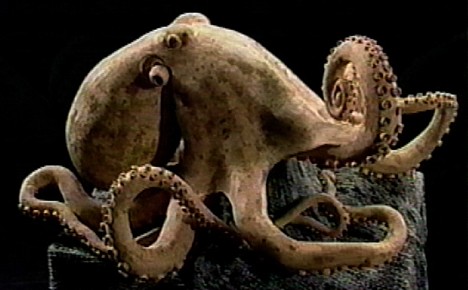
Recycle artist Masataka Koike creates realistic-looking marine life sculptures from used wooden chopsticks. This octopus, which took eight months to complete, is made of 2,000 chopsticks.

Recycle artist Masataka Koike creates realistic-looking marine life sculptures from used wooden chopsticks. This octopus, which took eight months to complete, is made of 2,000 chopsticks.
Flickr user modern_fred's Japanese movie monster scan collection includes a few vintage illustrations detailing the innards of Godzilla and other famous kaiju.
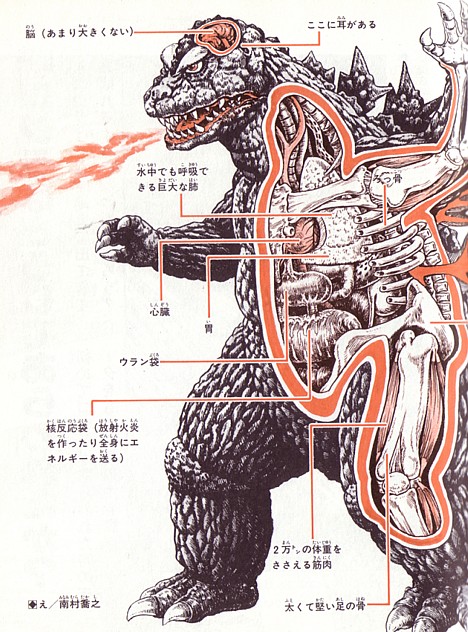
Godzilla
This anatomical sketch of Godzilla reveals a relatively small brain, giant lungs that allow underwater breathing, leg muscles that can support 20,000 tons of body weight, and a "uranium sack" and "nuclear reaction sack" that produce radioactive fire-breath and energize the body.
* * * * *
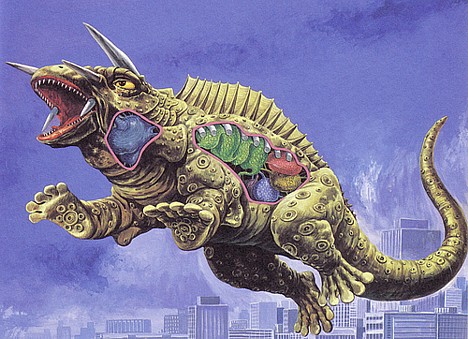
Jiger reveals her inner self
According to this anatomical drawing, Jiger has a pair of horns that can shoot missiles made of hardened saliva and one that fires a deadly magnetium (?) beam.
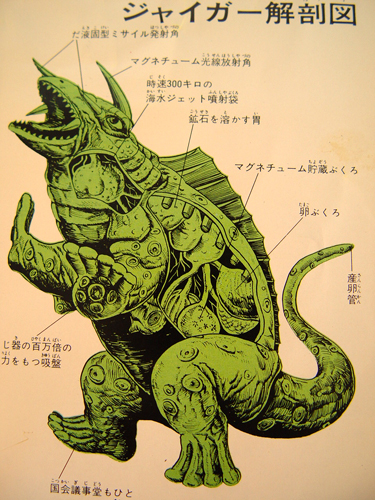
Jiger (uploaded by Paulkaiju)
Other characteristics include extremely powerful suction cups covering the entire body, an organ that enables Jiger to spit jets of seawater at 300 kilometers per hour, a stomach that can melt iron ore, and a tail that functions as an ovipositor.
* * * * *
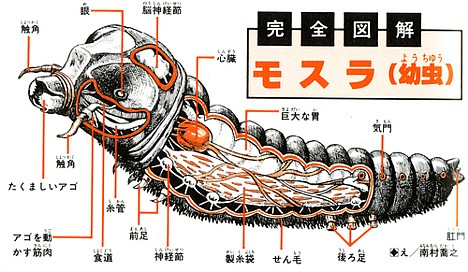
Mothra larva
This anatomical sketch of Mothra in larval form shows a robust jaw, an enormous stomach, an elongated silk-producing organ, a row of breathing orifices on either side of the body, countless cilia on the bottom surface, and a rudimentary nervous system consisting of a cerebral ganglion and a network of nerve ganglia distributed across the body.
* * * * *
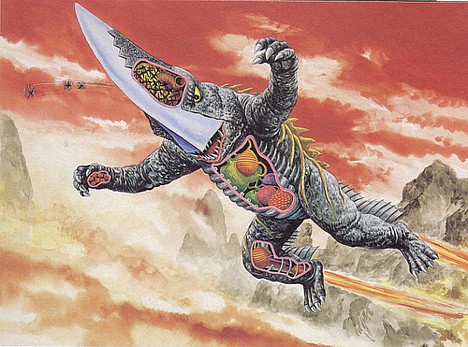
Guiron -- a peek inside the belly of the beast
* * * * *
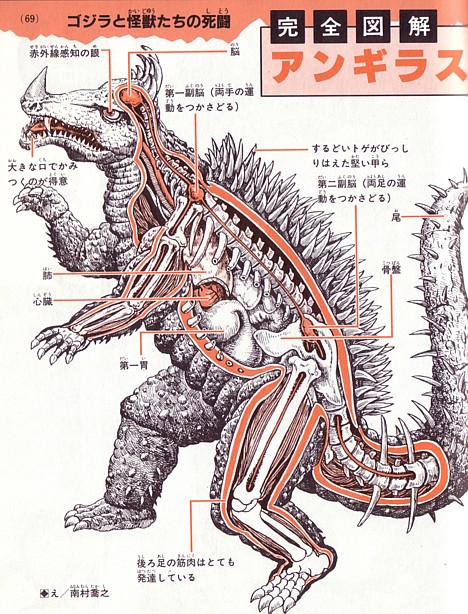
Anguirus
This anatomical diagram of Anguirus shows eyes that can detect infrared light, a pair of sub-brains that control the forelegs and rear legs, highly developed rear leg muscles, and a heavily spiked rear carapace.
* * * * *
This illustration of "Flaming Monster Gamera" (from An Anatomical Guide to Monsters) reveals eyes that can see in the dark, arms strong enough to lift and throw a 50-ton boat, and "fire sacks" that let Gamera shoot flames from his hands.
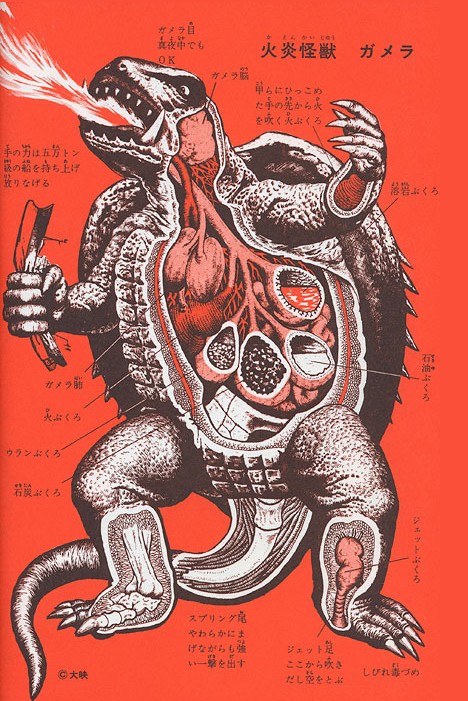
Gamera
The illustration also shows a series of sack-like organs for storing lava, oil, coal and uranium (like Godzilla), as well as balloon-like organs in the legs that can blast air through the bottoms of the feet.
[Link: modern_fred's kaiju eiga photoset]
Related: Kaiju art collection
Freelance creative designer Ryosuke Tei has done a few animated motion IDs for MTV Asia/China that are inspired by Saiyuki ("Journey to the West"), the classic Chinese adventure novel about a monk's trek to India in search of Buddhist texts.
In the first video, followers of the monk Genjo Sanzo (Xuanzang) psychically transmit a message from the Buddha urging him to go west.
The second one introduces the three protectors that accompany Sanzo on his quest: the powerful monkey king Son Goku (Sun Wukong), the gluttonous and libidinous pig Cho Hakkai (Zhu Bajie) and the river ogre Sa Gojo (Sha Wujing).
Check Tei's YouTube page for more animated shorts, including this music video for French electronica artist DJ Missill's "Forward," which features a giant guitar-playing robo-rabbit that frees the oppressed minds of jackbooted soldiers.
The video was produced by Furi Furi Company, the creative design agency Tei established and directed for 10 years before going freelance in 2008.
[Link: Ryosuke Tei]
Poor planning? Engineering gone wrong? Unconventional street decor? Whatever the explanation, this quiet residential street in Tokyo's Setagaya ward boasts perhaps the highest manhole density in town, with 85 of them scattered along a 200-meter stretch of pavement. Fans of the curious street call it "Manhole Ginza."
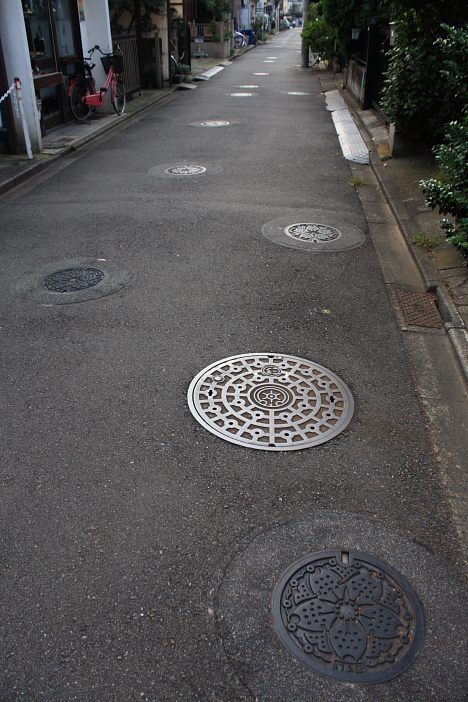
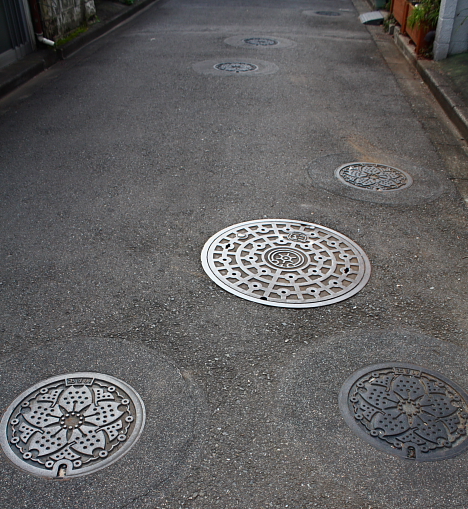
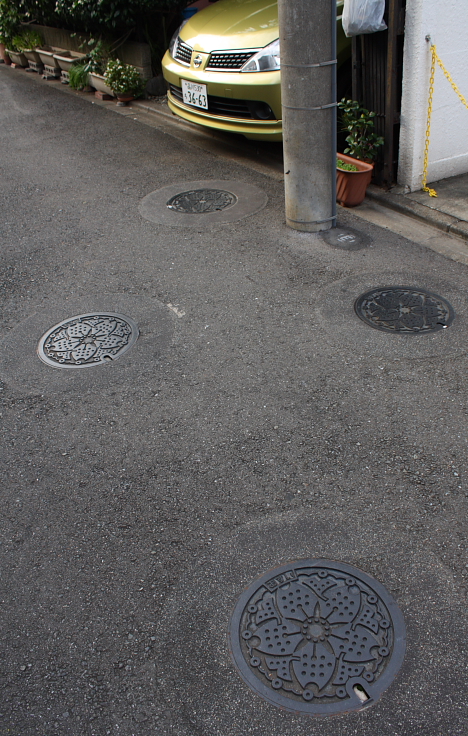
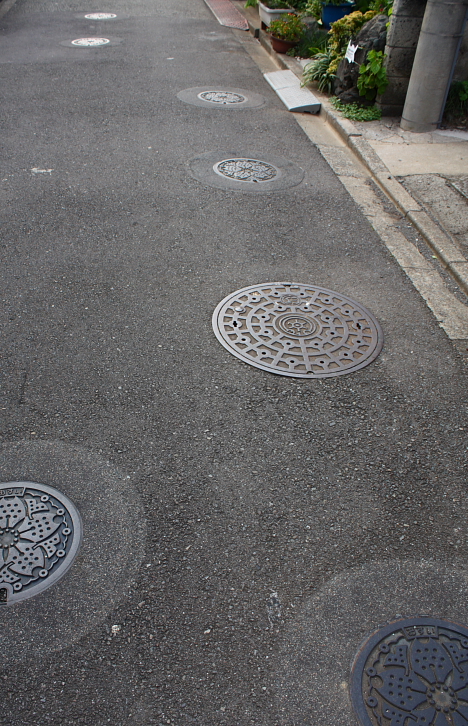
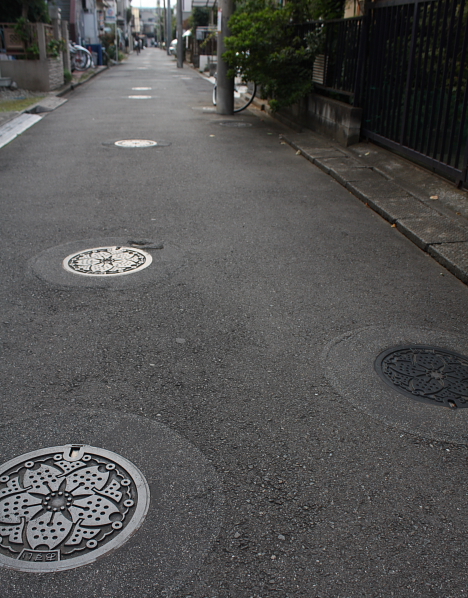
[Link: Google Maps]
Related: Japanese manhole covers
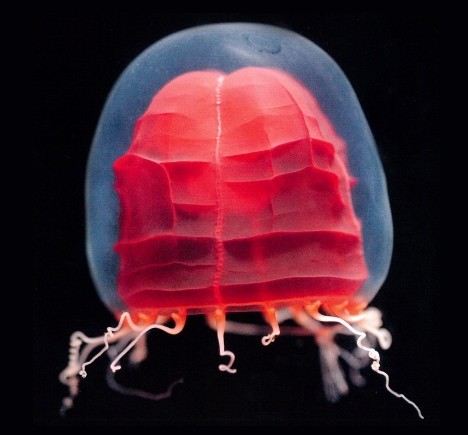
Red paper lanterns, or aka-chochin, are a familiar sight on the city streets of Japan, where they typically hang at the entrances to cheap pubs, capturing the attention of passersby. The ocean, however, is home to a different variety of red paper lantern -- an unusual species of deep-sea jellyfish.
Officially named Pandea rubra, the red paper lantern medusa (aka-chochin kurage) was first discovered in the Bering Sea in 1913, but details about its distribution and life cycle have long remained a mystery. In recent years, the creature has caught the eye of researchers at the Japan Agency for Marine-Earth Science and Technology (JAMSTEC) armed with high-definition video cameras.
Using manned and unmanned submersibles, the researchers have collected over 100 hours of high-definition footage showing more than 60 specimens of the jellyfish in waters from northeastern Honshu to Okinawa, at depths ranging from 500 to 1,000 meters. Here is some raw video:
The red paper lantern medusa has a transparent, bell-shaped hood measuring about 10 centimeters in diameter and 17 centimeters from top to bottom, with between 14 and 30 tentacles that extend up to 6 times the length of its body. Inside the transparent hood is a deep red colored mantle that can crumple up or expand like a paper lantern, hence the name. JAMSTEC researcher Dr. Dhugal Lindsay is credited with coming up with the name.
The gelatinous creature is commonly found at depths of between 450 to 900 meters in warm and temperate waters around the world. Observations have been reported in the Antarctic Ocean, but never in the Arctic Ocean.
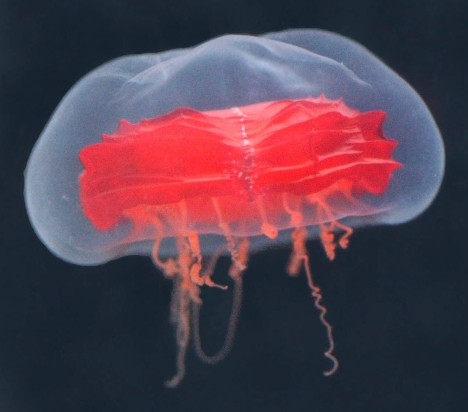
The JAMSTEC videos suggest that a variety of sea creatures regard the red paper lantern medusa as a safe place to establish temporary residence. In the video, the developing larvae of shrimp and sea spiders can be seen hitching extended rides on the jellyfish.
"We didn't expect to find such a variety of organisms attached to the jellyfish," said Dr. Dhugal Lindsay. "Humans apparently are not the only ones attracted to red paper lanterns."
[Source: Mainichi]

An Osaka University research team has demonstrated an "atomic pen" that can inscribe nano-sized text on metal by manipulating individual atoms on the surface.
According to the researchers, whose results appear in the October 17 edition of Science magazine, the atomic pen is built on a previous discovery that silicon atoms at the tip of an atomic force microscope probe will interchange with the tin atoms in the surface of a semiconductor sample when in close proximity. Using this atom-interchange phenomenon, the researchers were able to arrange individual silicon atoms one by one on a semiconductor surface to spell out the letters "Si." The writing process, which took about an hour and a half to complete, was conducted at room temperature.
The completed text measures 2 x 2 nanometers, which is roughly 40,000 times smaller than the width of the average human hair.
"It's not possible to write any smaller than this," said Masayuki Abe, a researcher involved in the project.
The ability to incorporate individual atoms into a surface could lead to a variety of advances in atomic scale technology, the researchers suggest. If used in chip manufacturing, for example, this technology could help build powerful computers the size of a wristwatch.
[Source: Asahi]
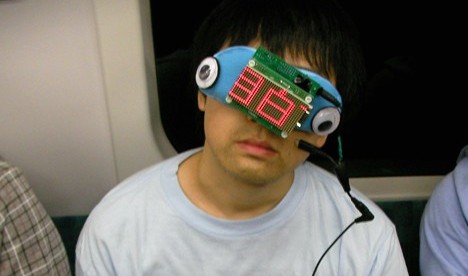
For drowsy train commuters afraid of sleeping past their stop, inventor and manga artist Pyocotan has developed "Noriko-san," a sleep mask with an electronic scrolling display that communicates the wearer's destination to fellow passengers.
Noriko-san is designed to give sleepyheads greater peace of mind (and thus a deeper level of sleep) by increasing the odds that a stranger will wake them in time. In theory, other passengers feel compelled to act either out of courtesy or simply so they can sit in the empty seat left behind. Here's a video of Pyocotan testing a prototype on Tokyo's Yamanote line.
The video shows Pyocotan board the Yamanote line at Nishi-Nippori station. When a seat becomes available, he sits down, slips on the mask and goes to sleep. The mask's scrolling message reads: "I will get off at Mejiro station." Unfortunately, nobody wakes him up when he arrives. The test fails.
Pyocotan admits that Noriko-san is not 100% effective, perhaps because the unusual appearance makes other passengers feel uncomfortable and prevents them from acting. But the device will likely grow more effective as it becomes more widespread, he suggests. Until then, the fact that the mask might encourage others to act makes it a little easier for the user to relax and sleep more soundly.
Noriko-san cost about 20,000 yen ($200) to develop.
[Source: INTER News]
For a brief period in the mid-1870s, artistic woodblock prints known as "newspaper nishiki-e" were a popular form of mass entertainment in Japan. These colorful prints fed the public's enormous appetite for sensationalism by retelling shocking stories culled from the major newspapers of the day. The Meiji government swiftly cracked down on the publishers of these "unofficial" sources of information, causing them to disappear as quickly as they had appeared, but not before hundreds of issues had been published and circulated around Japan. While newspaper nishiki-e most often retold stories of scandalous or heinous crimes, they occasionally presented accounts of monsters, ghosts and mysterious happenings, such as the ones included here.
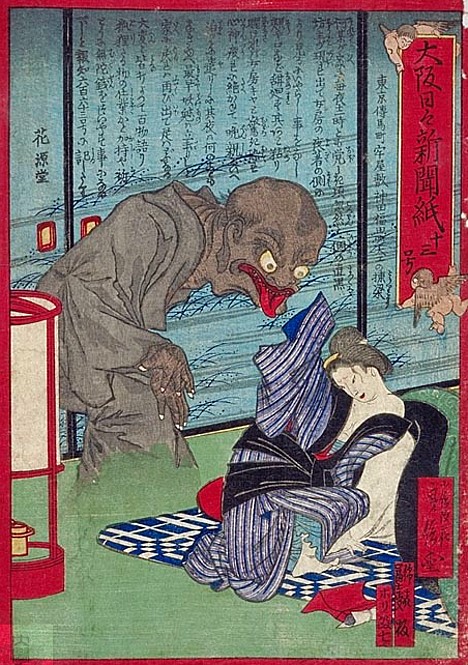
Osaka Nichinichi Shinbunshi, No. 13 (ca. 1875)
This print shows a lecherous monster said to have haunted the home of a master carpenter in the Kanda area of Tokyo. The apparition habitually showed up late at night to perform unspeakable acts on his sleeping wife, until the family enlisted the help of prayer-chanting priests to cleanse their home. In the Meiji era, recurring nightmares about this sort of monster were apparently quite common.
* * * * *
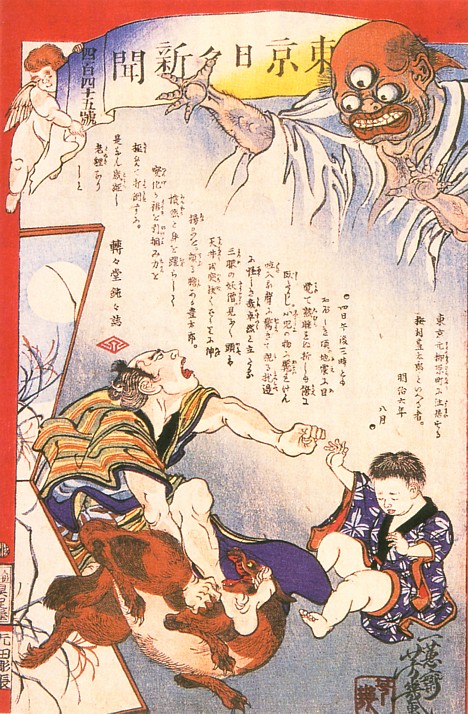
Tokyo Nichinichi Shinbun, No. 445 (1874)
In the early morning hours of August 4, 1873, a man named Umemura Toyotaro was awakened by an earthquake. As he struggled to get back to sleep, his child, who lay nearby, suddenly burst out crying hysterically. The man looked up to find a strange, three-eyed monk standing over them. He watched in disbelief as the mysterious monk grew taller and taller, until his head reached the ceiling. Unrattled, the man grabbed the monk's sleeve and pulled him to the ground. The monk turned out to be an old shape-shifting tanuki.
* * * * *
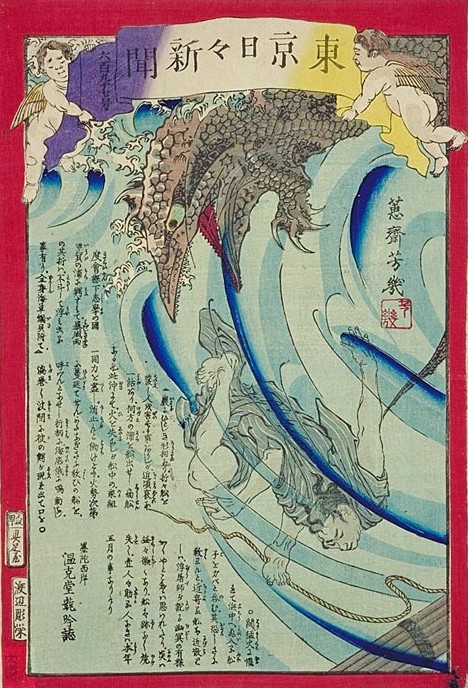
Tokyo Nichinichi Shinbun, No. 697 (May 25, 1874)
This print depicts a giant alligator inhabiting the Koga inlet of eastern Mie prefecture. The feared sea monster, which was described as being covered in seaweed and oysters, was known to attack ships and devour anyone thrown overboard. One day a ship in the area caught fire. As the crew abandoned the burning vessel, the creature ate them all.
* * * * *
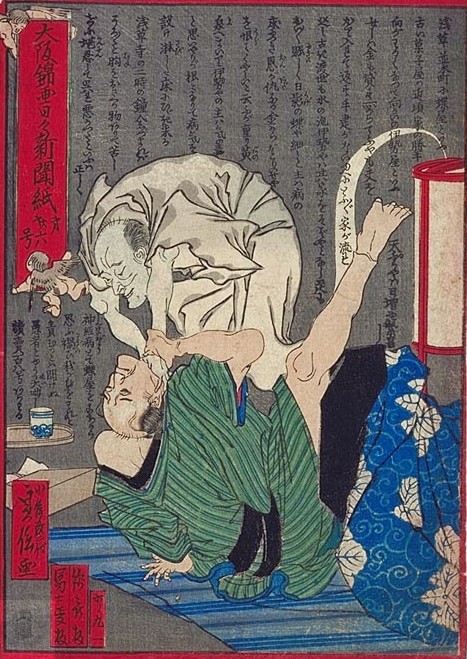
Osaka Nishiki-e Nichinichi Shinbunshi, No. 26 (ca. 1875)
This print shows the ghost of a disgruntled candy store owner who grew ill and died after falling deep in debt to his neighbor, the owner of a successful tempura restaurant. The ghost has returned to settle the score.
* * * * *
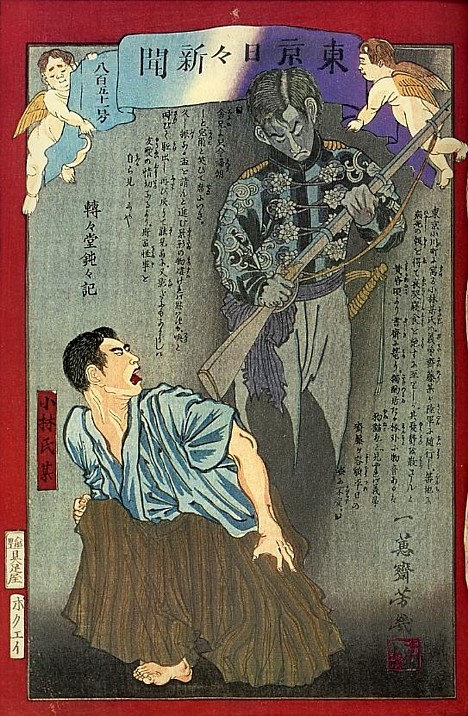
Tokyo Nichinichi Shinbun, No. 851 (1874)
In 1874, the Imperial Japanese Army and Navy embarked on the Taiwan Expedition of 1874, their first ever overseas deployment. This print depicts the restless spirit of a young Japanese soldier named Saito who died from illness during the mission. Saito's ghost returned home for several days to haunt his brother-in-law, who had grown very depressed after learning of Saito's fate.
* * * * *
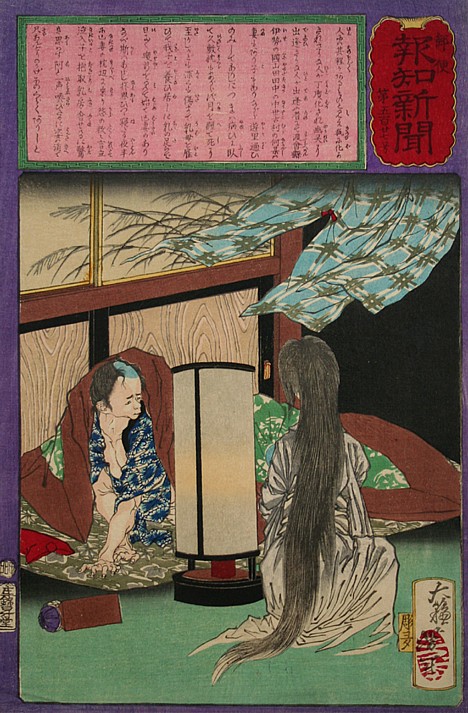
Yubin Hochi Shinbun, No. 527 (1875)
This print shows the restless ghost of a woman whose husband neglected her so much that she fell ill and died. Upset at the way he was raising their young child, she returned from the spirit world to complain in his ear while he slept. The baby woke up and began to cry, so she cradled it in her arms and began to nurse it. When the man awoke and screamed at the sight of his undead wife, she vanished.
* * * * *
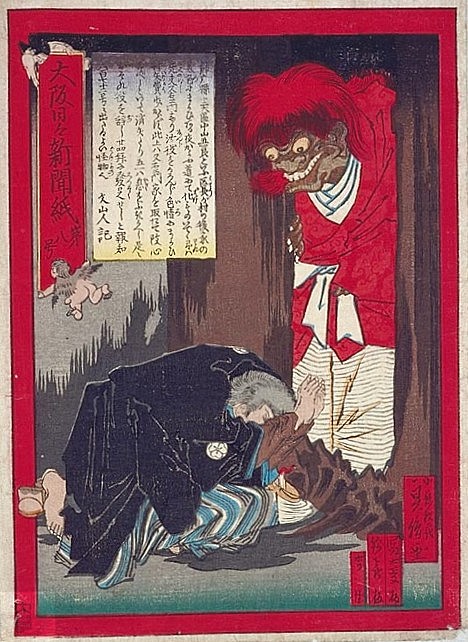
Osaka Nichinichi Shinbun, No. 8 (ca. 1875)
Despite appearances, this monster means no harm. The helpful creature is attempting to reform a failed Hyogo-area politician named Nakayama, who neglected his responsibilities after falling victim to a widow's charms.
* * * * *
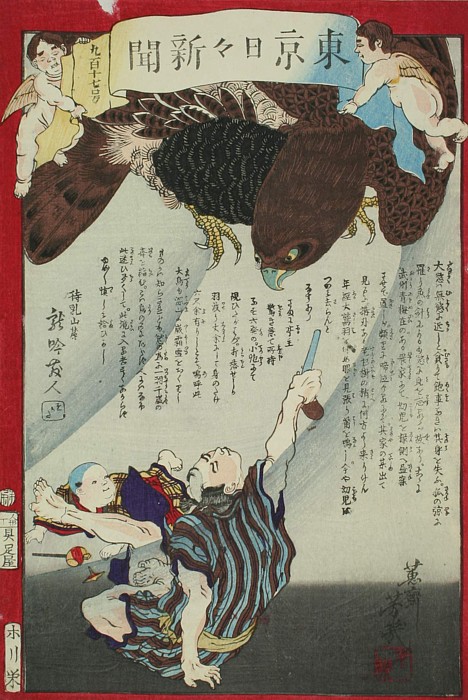
Tokyo Nichinichi Shinbun, No. 917
When a man stepped outside onto his veranda to check on his crying child, he was alarmed to find a gigantic eagle sitting in a cedar tree overhead. The creature, which stood taller than a grown man, was staring hungrily down at the child. In a panic, the man grabbed his gun and shot the menacing bird from its perch. The enormous size of the carcass astounded him.
* * * * *
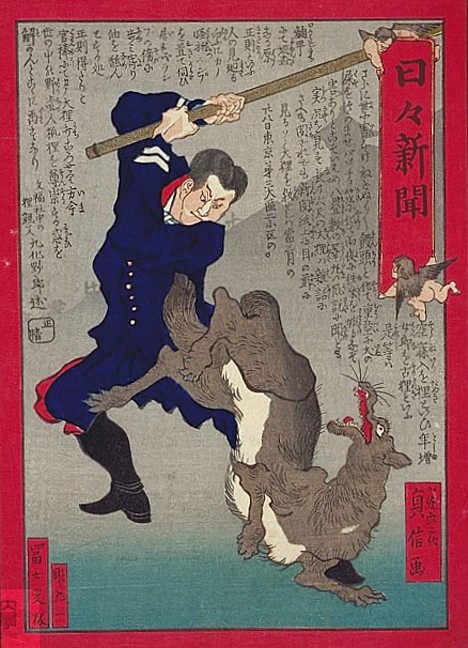
Nichinichi Shinbun (ca. 1875)
This print shows a policeman capturing a tanuki, a mythical trickster animal known for its ability to outwit humans. This nishiki-e can be viewed as a reflection of the identity struggle that Japan was experiencing at the time, with the tanuki symbolizing Japan's traditional past and the policeman symbolizing the "enlightened" modern society that rapidly emerged after the Meiji Restoration of 1868.
[Some scans via: Waseda University Library // Further reading: News nishikie]
Related:
- 19th-century ghost scrolls
- Edo-period monster paintings by Sawaki Suushi
Here are some of the friendly faces seen at the Robo Japan 2008 exhibition held at Pacifico Yokohama Hall this weekend.
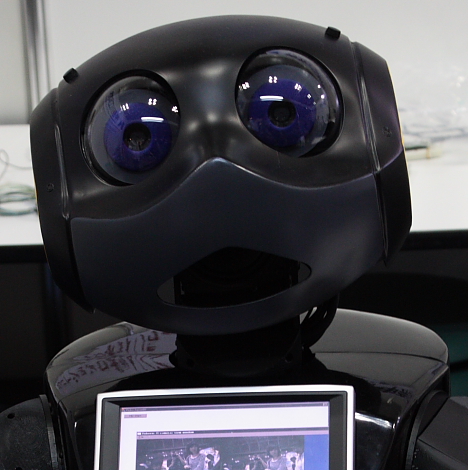
Noir
The Kanagawa Institute of Technology exhibited Noir, a blue-eyed "grandchild" robot designed to communicate with and help take care of the elderly. This modified version of Vstone's Robovie-R robot can carry on a basic conversation, sing songs, and play rock-paper-scissors.
* * * * *
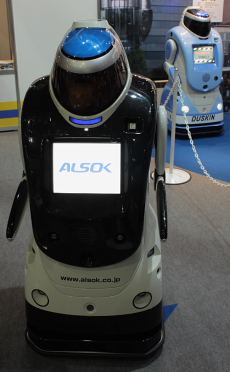
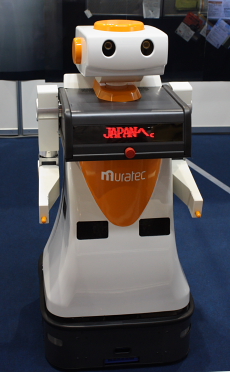
Reborg-Q // MKR-003
Security firm ALSOK showed off Reborg-Q (left), a patrolling security robot that keeps an eye out for suspicious activity in public places while entertaining the kids. Keio University's MKR-003 (right) is an autonomous robot designed to carry medical supplies around inside hospitals. The robot can map and understand its own location inside the hospital, avoid obstacles, and verbally communicate with human co-workers and hospital visitors.
* * * * *
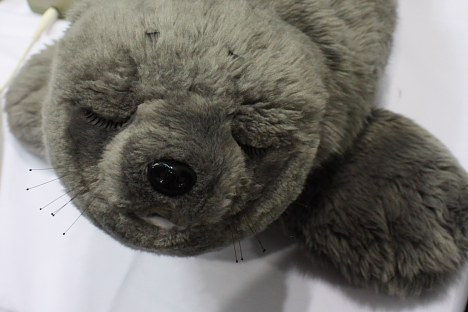
Gray-brown Paro
The uber-famous Paro "Mental Commit Robot" appeared in various colors at the National Institute of Advanced Industrial Science and Technology (AIST) booth.
* * * * *
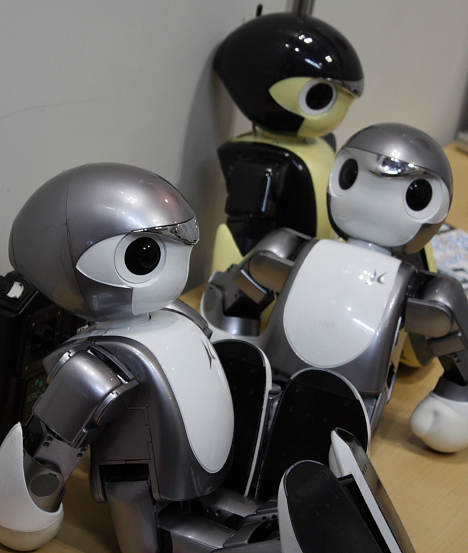
Manoi athlete humanoids
Kyosho exhibited their line of Manoi humanoid athlete robots. Here they are relaxing.
* * * * *

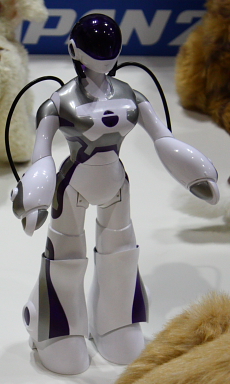
Yume-Neko Smile // EMA
Sega Toys' robot toy display included the Yume-Neko Smile cat robot (left) and EMA (Eternal Maiden Actualization), an interactive mini-fembot that can sing, dance and strut like a runway model (right).
* * * * *
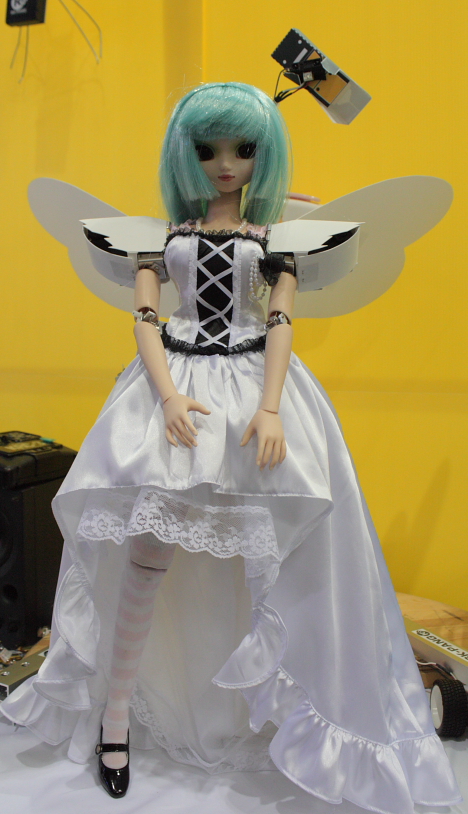
AYA
Robot creator SK-PANG demonstrated AYA, a stand-mounted mini-android that dances and sings tunes created with the popular Vocaloid software.
* * * * *
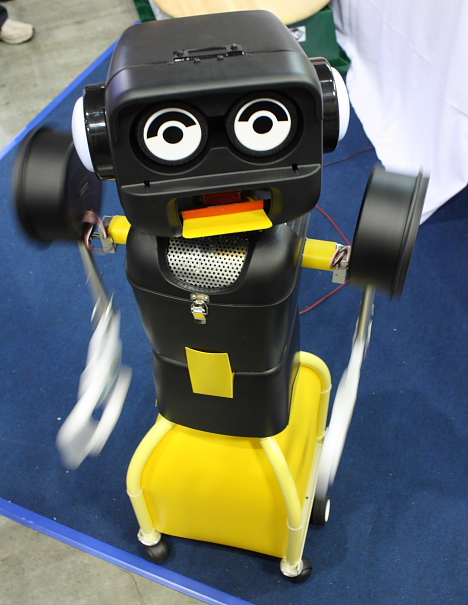
HASIMOTO 3
HASIMOTO 3, also created by SK-PANG, is an in-your-face entertainment robot designed to work the crowd at special events.
* * * * *
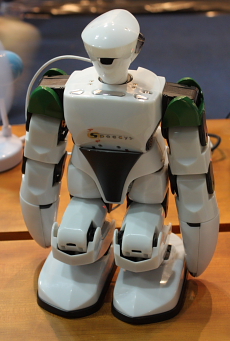
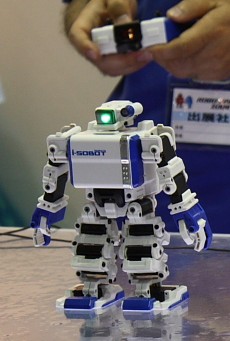
SPC?101C // i-SOBOT
Speecys showcased the many talents of the SPC-101C programmable family entertainment robot (left). Takara Tomy exhibited the tiny i-SOBOT humanoid (right).
* * * * *
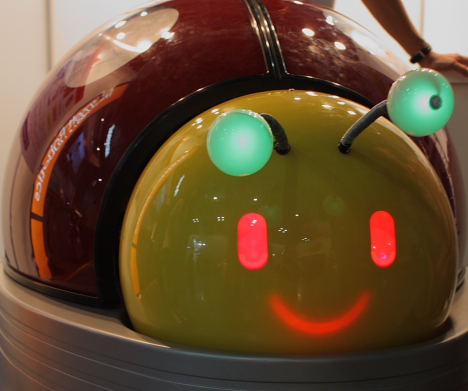
LadyBird
LadyBird, a large, autonomous ladybug-shaped robot developed by Chinougijutsu Co., Ltd., is designed to clean public restrooms. Microphones, speech recognition software and a voice synthesizer enable the friendly robot to carry on a basic conversation.
* * * * *
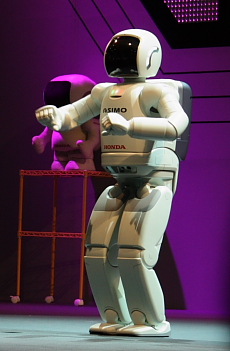
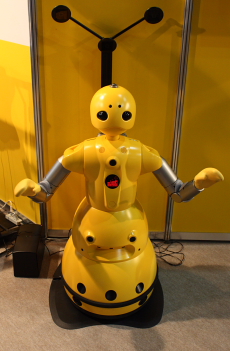
Asimo // Wakamaru
Honda's Asimo (left) entertained crowds by dancing, running, kicking soccer balls and carrying drinks. Mitsubishi's Wakamaru (right) charmed onlookers with its grin and showed how Kyokko Inc.'s flexible sensor tube (FST) body suit can be used as a remote robot controller.
* * * * *
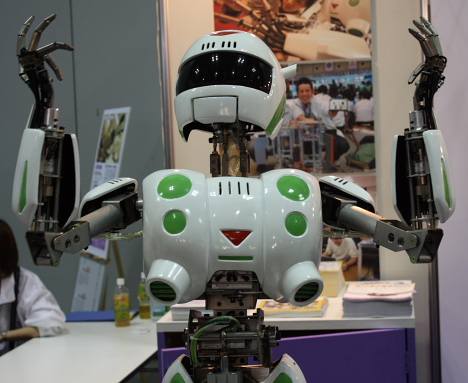
KARFE
KARFE, an educational/comedian robot developed by Nihon Kogakuin College, told jokes to all who would listen.